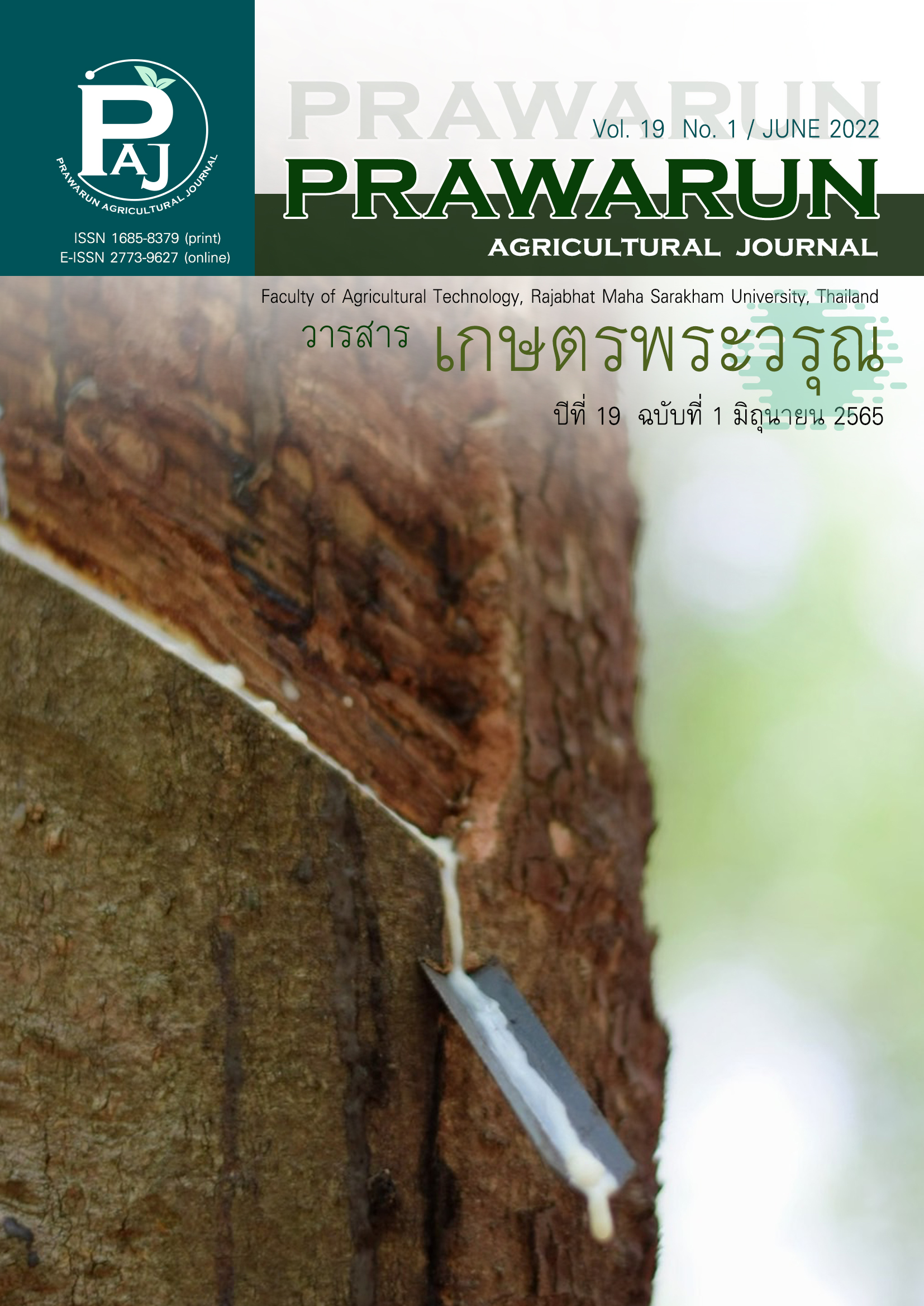การศึกษาสมบัติทางด้านความหนืดแป้งข้าวโพดข้าวเหนียวและค้นหาสนิปส์ของยีน Waxy และ Dull-I ในข้าวโพดข้าวเหนียว
Main Article Content
บทคัดย่อ
การประเมินสมบัติทางด้านความหนืดของฟลาวร์ข้าวโพดข้าวเหนียวด้วยเครื่องวัดความหนืดแบบรวดเร็ว (Rapid Visco Analyzer หรือ RVA) จากฟลาวร์ข้าวโพดข้าวเหนียว 30 พันธุ์/สายพันธุ์/ลูกผสม ประกอบด้วย ข้าวโพดข้าวเหนียวสายพันธุ์แท้ (Inbred lines) ข้าวโพดข้าวเหนียวลูกผสม (Hybrids) และข้าวโพดข้าวเหนียวลูกผสมพันธุ์การค้า (Commercial hybrids) ซึ่งถูกนำมาใช้เป็นพันธุ์เปรียบเทียบ พบว่าฟลาวร์ที่ได้จากข้าวโพดข้าวเหนียว สายพันธุ์แท้ WKA005 WKNN016 YNB01 และ WPK018 มีค่าความหนืดสูงสุด การแตกตัวของเม็ดแป้ง และค่าการคืนตัวน้อยกว่าพันธุ์เปรียบเทียบ ในขณะที่ฟลาวร์ที่ได้จากข้าวโพดข้าวเหนียวลูกผสม UT1122 UTI11 และ UTI22 มีค่าการคืนตัวสูงกว่าพันธุ์เปรียบเทียบ เมื่อพิจารณาลำดับนิวคลีโอไทด์ของยีน Waxy และ Dull ซึ่งแปลงข้อมูลเป็นเอนไซม์ GBSSI เกี่ยวข้องกับการสังเคราะห์อะไมโลส และเอนไซม์ SSIII ซึ่งเกี่ยวข้องกับการควบคุมหลักการต่อสายอะไมโลเพคตินในเม็ดแป้ง จากผลงานวิจัยนี้สามารถตรวจพบความผันแปรทางพันธุกรรมของลำดับนิวคลีโอไทด์ของยีน Waxy 20 ตำแหน่ง แต่ไม่มีความสัมพันธ์ระหว่างจีโนไทป์กับลักษณะความหนืด ในขณะที่การวิเคราะห์ความผันแปรลำดับนิวคลีโอไทด์ส่วนที่เป็น เอ็กซอนของยีน Dull มีตำแหน่งความผันแปรของลำดับนิวคลีโอไทด์แบบสนิปส์จำนวน 7 ตำแหน่ง ได้แก่ ตำแหน่งที่ A28G C34T A55G G130T G213A A430C และ T480C เมื่อนำลำดับนิวคลีโอไทด์บริเวณเอ็กซอน มาถอดรหัสกรดอะมิโน พบว่ามีตำแหน่งความผันแปรของลำดับนิวคลีโอไทด์แบบสนิปส์ยีน Dull ตำแหน่งที่ G130T G213A และ T480C ทำให้กรดอะมิโนเปลี่ยนแปลง 3 ตำแหน่ง และมีความสัมพันธ์กับลักษณะความหนืด ดังนั้น ยีน Dull สามารถนำไปสร้างเป็นเครื่องหมาย ดีเอ็นเอสำหรับนำไปใช้ในการช่วยคัดเลือกข้าวโพดข้าวเหนียวที่มีลักษณะคุณภาพด้านการบริโภคที่ดีได้
Article Details
เอกสารอ้างอิง
Bao, J. D., Yao, J. Q., Zhu, J. Q., Hu, W. M., Cai, D. G., Li, Y., Shu, Q. Y. & Fan L. J. (2012). Identification of glutinous maize landraces and inbred lines with altered transcription of waxy gene. Molecular Breeding, 30, 1707–1714.
Fan, L., Quan, L., Leng, X., Guo, X., Hu, W., Ruan, S., Ma, H., & Zeng M. (2008). Molecular evidence for post–domestication selection in the waxy gene of Chinese waxy maize. Molecular Breeding, 22, 329–338.
Fujita, N., Yoshida, M., Kondo, T., Saito, K., Utsumi, Y., Tokunaga, T., Nishi, A., Satoh, H., Park, J. H., Jane, J. L., Miyao, A., Hirochika H., & Nakamura, Y. (2007). Characterization of SSIIIa–deficient mutants of rice: the function of SSIIIa and pleiotropic effects by SSIIIa deficiency in the rice endosperm. Plant Physiology, 144(4), 2009–2023.
Jane, J., Chen, Y. Y., Lee, L. F., McPherson, A. E., Wong, K. S., Radosavljevic, M., & Kasemsuwan, T. (1999). Effects of amylopectin branch chain length and amylose content on the gelatinization and pasting properties of starch. Cereal Chemistry, 76(5), 629–637.
Ketthaisong, D., & Lertrat, K. (2015). Application of a rapid visco analyzer in inbred line evaluation for producing single cross waxy corn hybrid variety. Khon Kaen Agriculture Journal, 43(supplement 1), 888–893. (in Thai)
Klosgen, R. B., Gierl, A., Schwarz–Sommer, Z., & Saedler, H. (1986). Molecular analysis of the waxy locus of Zea mays. Molecular and general Genetics, 203, 237–244.
Lapkhoksung, A. (2012). Effects of amylose content and amylopectin structure of different starch varieties on resistant starch type III formation. (Master’s thesis). Nakhon Ratchasima. Suranee University of Technology. (in Thai)
Lin, Q., Huang, B., Zhang, M., Zhang, X., Rivenbark, J., Lappe, R. L., James, M. G., Myers, A. M., & Hennen–Bierwagen, T. A. (2012). Functional interactions between starch synthase III and isoamylase–type starch–debranching enzyme in maize endosperm. Plant Physiology, 158(2), 679–692.
Newport Scientific. (1997). Operation Manual for the Series 4 Rapid Visco Analyzer. Newport Scientific Pty, Ltd., Australia. 93 p.
Simla, S., & Hemathulin, A. (2012). Physiochemical properties of flour waxy corn. Khon Kaen Agricultural Journal, 40(supplement 1), 455–459. (In Thai).
Sudtasarn, G., & Kenlueam, R. (2013). Changes during storage in starch viscosity and quality of Northeastern rainfed lowland rice lines. Proceeding of the 30th rice and temperate cereal crops annual conference (pp. 314–315). Bangkok: Bureau of rice reserch and development. (in Thai).
Valle, G. D., Colonna, P., & Patria, A. (1996). Influence of amylose content on the viscous behavior of low hydrated molten starches. Journal of Rheology, 40, 347–362.
Wilson, L. M., Whitt, S. R., Ibanez, A. M., Rocheford, T. R., Goodman, M. M., & Buckler, E. S. (2004). Dissection of maize kernel composition and starch production by candidate gene association. The Plant Cell, 16(10), 2719–2733.
Zheng, H., Wang, H., Yang, H., Wu, J., Shi, B., Cai, R., Xu, Y., Wu, A., & Luo, L. (2013). Genetic diversity and molecular evolution of Chinese waxy maize germplasm. PLoS One, 8(6): e66606.


